The Automated CPR Device market is experiencing strong growth driven by the increasing focus on improving survival rates during cardiac emergencies. The market’s future outlook is shaped by the rising prevalence of cardiovascular diseases, growing awareness about sudden cardiac arrest, and the adoption of advanced resuscitation technologies by healthcare providers. Investments in emergency response infrastructure, particularly in developed and urban regions, have facilitated the integration of automated CPR devices into emergency medical protocols.
Technological advancements, such as battery-driven systems and compact, portable designs, have enhanced the usability and reliability of these devices in diverse environments. Moreover, initiatives to train emergency personnel and first responders in advanced life support have further increased the deployment of automated CPR devices.
The market is also benefiting from an emphasis on real-time monitoring, data recording, and integration with broader healthcare systems, which support better patient outcomes With the growing focus on timely intervention and the global push to reduce mortality from cardiac arrest, automated CPR devices are poised to maintain a strong demand trajectory across emergency medical settings.
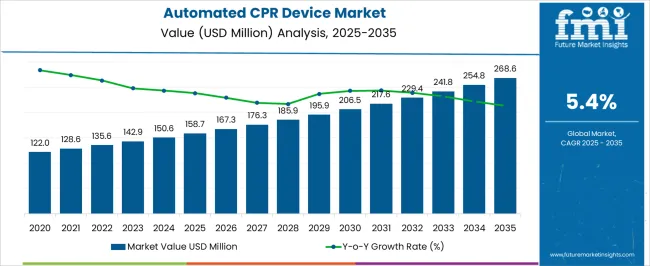
| Metric | Value |
|---|---|
| Automated CPR Device Market Estimated Value in (2025 E) | USD 158.7 million |
| Automated CPR Device Market Forecast Value in (2035 F) | USD 268.6 million |
| Forecast CAGR (2025 to 2035) | 5.4% |
The market is segmented by Product, Modality, and End-User and region. By Product, the market is divided into Piston-Based Devices and Load-Distributing Band-Based Devices. In terms of Modality, the market is classified into Battery-Driven and Electrically-Driven. Based on End-User, the market is segmented into Emergency Medical Services, Hospitals, Ambulatory Medical Centers, Specialty Clinics, Independent Catheterization Labs, and Long-Term Care Centers. Regionally, the market is classified into North America, Latin America, Western Europe, Eastern Europe, Balkan & Baltic Countries, Russia & Belarus, Central Asia, East Asia, South Asia & Pacific, and the Middle East & Africa.
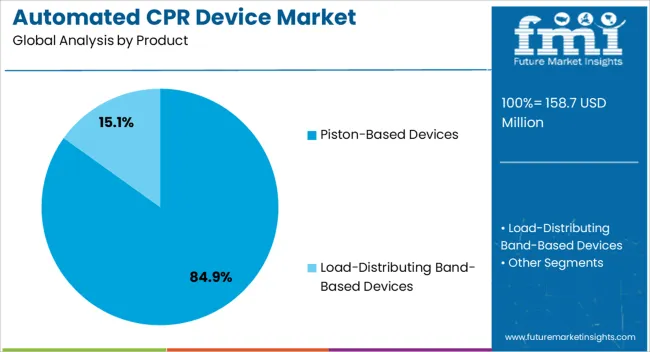
The piston-based device segment is projected to hold 84.90% of the Automated CPR Device market revenue share in 2025, establishing it as the leading product type. This dominance is attributed to its high efficiency in delivering consistent and controlled chest compressions, which are critical for patient survival during cardiac arrest.
The design enables easy deployment in emergency situations and provides reliable performance across different patient profiles and clinical settings. The widespread adoption of piston-based systems is further reinforced by their proven effectiveness, durability, and compatibility with both manual and automated resuscitation protocols.
Additionally, growing investments in pre-hospital emergency care and the increasing presence of automated CPR devices in ambulances and hospitals have supported this segment’s growth The ability of piston-based devices to integrate with monitoring equipment and record data for post-event analysis has also enhanced their adoption, making them the preferred choice for emergency medical services and clinical responders globally.
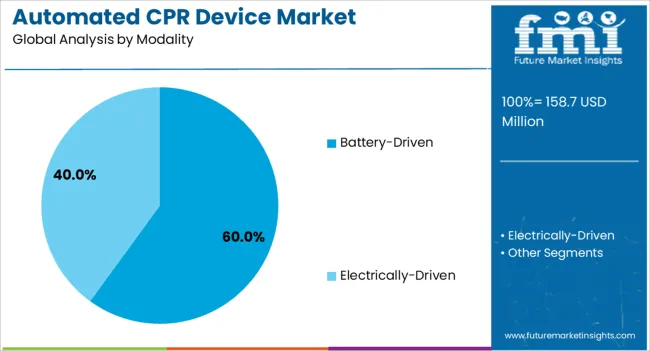
The battery-driven modality segment is expected to account for 60.00% of the Automated CPR Device market revenue share in 2025, positioning it as the leading modality. This growth is driven by the need for portable and reliable devices that can function efficiently in pre-hospital and field settings.
Battery-driven devices offer flexibility, ease of transport, and independence from external power sources, which is crucial for emergency responders operating in unpredictable environments. The adoption of battery-driven systems has been further encouraged by improvements in battery technology, including longer operational life and rapid recharging capabilities, which ensure uninterrupted performance during critical interventions.
Moreover, the integration of intelligent controls and feedback mechanisms enhances compression quality and device reliability These factors, combined with increased awareness among emergency medical personnel about the benefits of battery-operated devices, have contributed to the strong market position of this segment.
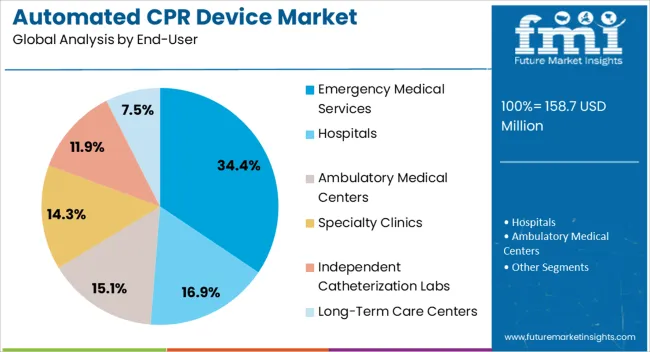
The emergency medical services end-user segment is anticipated to hold 34.40% of the Automated CPR Device market revenue in 2025, making it the leading end-use industry. The growth of this segment is influenced by the critical role of EMS providers in responding to cardiac emergencies and the emphasis on delivering high-quality, life-saving interventions outside hospital settings.
Automated CPR devices enhance the efficiency of EMS teams by providing consistent chest compressions while freeing personnel to manage other aspects of patient care. The deployment of these devices across ambulances, rapid response units, and first responder teams has been accelerated by training initiatives and protocol standardization.
Furthermore, EMS organizations are increasingly integrating automated CPR devices with telemedicine and patient monitoring systems, which improves clinical decision-making and patient outcomes The rising investment in emergency healthcare infrastructure and the focus on reducing pre-hospital mortality rates are key factors sustaining the growth of the EMS segment within the automated CPR device market.
Increasing Demand for Remote-controlled Automatic Chest Compression Devices
Remote-controlled automated CPR devices are a significant advancement in resuscitation technology. The prototype ROSCER (Remote-Controlled Automatic Chest Compression) is being developed by researchers. This offers several key features that set it apart from conventional mechanical CPR devices.
ROSCER delivers continuous chest compressions without interruption during cardiopulmonary resuscitation (CPR). This uninterrupted flow results in optimal blood circulation and oxygen delivery to vital organs during cardiac arrest.
Unlike manual chest compressions, ROSCER ensures consistent and precise compression depth and timing. Also, the remote control capability minimizes the exposure of rescuers to infectious diseases.
In high-risk situations, such as during a pandemic or when dealing with contagious patients, ROSCER reduces direct physical contact between rescuers and patients. This enables rescuers to adjust compression parameters from a safe distance, enhancing both safety and infection control.
Growing Adoption of Suction Cups in Piston Devices is a Key Trend
Mechanical chest compression devices are largely preferred, offering consistent and high-quality chest compressions during cardiopulmonary resuscitation (CPR). These devices are safe and effective in both experimental as well as clinical settings.
Among mechanical CPR devices, piston-based designs stand out. These closely mimic the gold standard treatment—manual chest compressions. However, achieving optimal results requires addressing an essential aspect: the release of thoracic pressure between compressions.
Few companies have included suction cups within piston type automatic CPR devices. These cups assist in returning the thorax to its neutral position after each compression. This is crucial because when the thoracic cage undergoes deformation, the natural elastic recoil may fail.
The suction cup aids in restoring the chest to its baseline state. This allows for better cardiac refill and improved overall cardiac output.
Studies in animal models have demonstrated that active decompression can enhance both cardiac output and cerebral blood flow. Hence, the use of suction cups in piston-based automated CPR devices has become a trend.
Risk of Injury in Automated Chest Compression to Damp Industry Growth
Automated CPR devices are substantially heavy and can cause injuries such as rib fractures, sternal fractures, and internal organ fractures on application. This is lowering the adoption rate, thereby negatively impacting industry growth.
According to a study published by the Official Journal of the European Resuscitation Council, manual compression has a lower risk of compression-induced injuries. As a result, many end users prefer the same over the automatic one.
Automated CPR device LUCAS led to 8 injuries out of a total of 11 tested cases, but for manual compression, this counts for 3 out of 11 cases. Also, the figure for sternal fractures stood at 4 out of 11 and 1 out of 11 for LUCAS and manual CPR, respectively.
According to BMC Emergency Medicine, the average weight of a mechanical CPR device is 11.6 kg, including the battery. The AutoPulse by ZOLL Medical Corporation weighs around 12.7 kg, including the battery. Such heavy weights can be extremely cumbersome and even dangerous to patients.
This increased incidence of injuries can hamper the widespread adoption of automated CPR devices.
Global automated CPR device sales increased at a CAGR of 4.3% from 2020 to 2025. Looking ahead, the automated CPR device future scope worldwide looks bright. Projections are that expenditure on mechanical CPR devices will likely rise at 5.4% CAGR through 2035.
Governments across the globe are investing in emergency medical services and other healthcare infrastructure to establish value-based healthcare. This is expected to boost growth of automated CPR device market during the forecast period.
According to the CMS (Centers for Medicare and Medicaid Services), United States healthcare spending grew by 4.1% in 2025, reaching USD 4.5 trillion. The federal share of Medicaid payments has also seen growth.
According to the report released by the State Comptroller, county governments in the United States over the last decade have tripled spending on ambulance service. Courtesy of this, the nation is set to remain a key consumer of mechanical CPR devices.
In 2024, Asia Development Bank (ADB) inked a USD 600 million loan to improve critical health services in Asia. According to the UNICEF report the emerging countries in Asia need to spend 5 to 7.5% of GDP on healthcare, which is currently at 1.2%.
The COVID-19 pandemic also uncovered the critical need to establish a robust healthcare system. Similar initiatives have been adopted in other parts of the world, creating growth prospects for the mechanical CPR device industry.
According to the 2025 report by WHO, around 1.169 million people die due to road crashes, and 20 to 50 million people suffer from non-fatal injuries.
As the global focus is shifting toward establishing a strong healthcare infrastructure, the emergence of medical services (EMS) will increase. This rise in EMS is expected to provide an upward trajectory to the market.
The section below depicts automated CPR device market forecast across various countries. China and the United Kingdom are set to exhibit high CAGRs of 8.5% and 5.8%, respectively, through 2035.
The regional analysis of automated CPR devices market is also given to determine key pockets for companies closely. Information about current trends in automatic CPR device industry is also provided in the full report.
North America, spearheaded by the United States, leads from the forefront when it comes to adoption of novel medical technologies like automatic CPR devices. Expanding healthcare infrastructure and high chronic disease burden are few growth drivers for automated CPR device market in Asia Pacific.
Innovation in medical technology is set to create automated CPR device market opportunities in Europe. Similarly, increasing government initiatives and investment will likely benefit the industry.
| Countries | CAGR 2025 to 2035 |
|---|---|
| United States | 3.3% |
| Germany | 4.6% |
| France | 5.3% |
| United Kingdom | 5.8% |
| China | 8.5% |
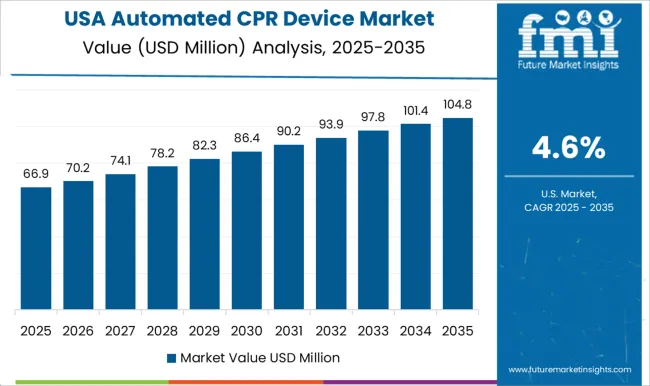
The United States automated CPR device market is projected to exhibit a CAGR of 3.3% during the assessment period. By 2035, sales of mechanical CPR devices in the nations are set to total USD 50.1 million.
The United States has the leading emergency medical services (EMS) systems in the world. There are around 18,200 local EMS agencies across all 50 states, Puerto Rico, Washington, D.C., and American Samoa.
According to the National EMS Assessment of 2024, local emergency medical service (EMS) agencies respond to around 28.5 million 911 dispatched annually. As automated CPR devices are widely used by emergency medical services, having a strong EMS infrastructure will likely contribute to industry growth.
Automated CPR device demand in Germany is poised to rise at a CAGR of 4.6% during the forecast period. By 2035, Germany is expected to account for 20.8% of mechanical chest compression device sales in Western Europe. This growth is mostly fueled by increasing incidence of cardiovascular illnesses.
Cardiovascular diseases such as sudden cardiac death (SCD) are the leading cause of death in Germany. An estimated 65,000 people die from SCD annually in Germany, which accounts for 20% of CVD deaths. This is expected to create growth opportunities for automated CPR manufacturers.
The EMS system in Germany is not centralized. Individual cities provide it. The country has well developed EMS infrastructure, leading to increasing demand for mechanical CPR devices.
Consumption of automated CPR devices in France is projected to increase at a value CAGR of 5.3% over the next ten years. By 2035, the industry size in France is forecast to reach USD 13.4 million, accounting for a share of 16.8% in Western Europe.
Life expectancy across the world has increased significantly, especially in developed countries such as France. This has led to an increasing geriatric population. In 2025, the percentage of people over 60 was 26%, which is around a quarter of the population.
By 2040, this share will increase to become one-third of the total population. Also, around 90% growth is expected between 2035 and 2050 in the population of 85+ age group, as the baby boomer population reaches old age. This rise in the elderly population, coupled with the robust healthcare infrastructure, is fuelling the adoption of mechanical CPR devices in France.
The section below sheds some light on key segments and anticipated growth rates. The detailed automated CPR device market segmentation analysis can help companies invest in popular products and frame new strategies accordingly.
Based on product, piston-based devices segment is set to dominate the industry, accounting for a value share of 84.9% in 2025. By end-user, the latest analysis of automated CPR device industry estimates emergency medical services segment to account for a share of 34.4% in 2025.
| Segment | Piston-based Devices (Product Type) |
|---|---|
| Value Share (2025) | 84.9% |
Sales of piston-based automated CPR devices are projected to register a CAGR of 5.1% from 2025 to 2035. The target segment is forecast to account for a prominent revenue share of 84.9% in 2025.
Multiple factors are expected to boost growth of the target segment. These include the wider availability of piston-based devices and close resemblance to the traditional manual chest compression.
Piston-based devices are widely used, owing to better mimicking manual chest compression capabilities, which is considered the gold standard treatment for cardiac arrest. Another advantage is the usage of suction cups which offer total release for thorax between compressions.
Unlike mechanisms like pneumatic mechanisms and load-distributing brands, piston-based devices are more effective in delivering consistent chest compressions. These have the ability to maintain a consistent depth and rate.
Piston-based devices are manufactured by most of the industry players, while limited companies manufacture load-distribution band-based devices. Advantages like portability and ease of use also improve piston-based devices’ popularity globally.
| Segment | Emergency Medical Services (End-user) |
|---|---|
| Value Share (2025) | 34.4% |
The emergency medical service segment is anticipated to advance at 2.6% CAGR during the projection period. The segment will likely account for a value share of 34.4% in 2025. This can be attributed to increased demand for CPR in emergencies.
There has been a constant rise in emergency medical services across the globe. EMS has a huge demand for automated CPR devices because of several reasons. Automated CPR allows rescuers to focus on other critical interventions.
Performing manual CPR can be fatiguing, and in the case of female rescuers, it can be even more challenging. Automated devices deliver chest compression at adjusted depth for extended periods during transportation.
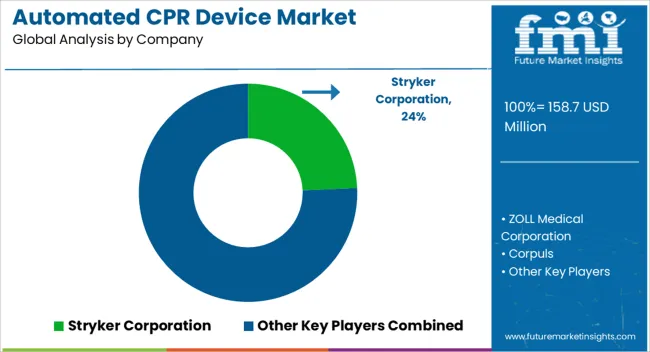
The mechanical CPR device market encompasses a diverse and dynamic competitive landscape. Leading automated CPR device manufacturing companies are focusing on new product launches and approvals to stay ahead of the competition.
Several companies are focusing on strengthening presence across regions with high chronic disease prevalence and aging populations. This is because these factors often increase chances of cardiac arrest.
Key players are also striving to increase the adoption of mechanical CPR devices by investing in awareness campaigns. Showcasing latest CPR device innovations at tradeshows and other exhibitions is also becoming a key strategy of companies.
Partnership and support from government agencies are also helping companies to boost sales. Many government agencies are offering grants for purchase of mechanical CPR devices.
There has also been an increased demand for CPR solutions from fire safety department, which has improved the uptake of mechanical CPR devices. Players are also deploying strategies such as mergers, distribution agreements, collaborations, and acquisitions to increase market reach.
Industry Updates
Based on product, the industry has been categorized into piston-based devices and load-distributing band-based devices.
In terms of modality, the market is categorized into battery-driven and electrically-driven.
Different end-users include hospitals (emergency departments, ICUs, and others), ambulatory medical centers, specialty clinics, emergency medical services (ambulances and air ambulances), independent catheterization labs, and long-term care centers.
Industry analysis has been carried out in key countries of North America, Latin America, East Asia, South Asia and Pacific, Western Europe, Eastern Europe, and Middle East and Africa.
The global automated cpr device market is estimated to be valued at USD 158.7 million in 2025.
The market size for the automated cpr device market is projected to reach USD 268.6 million by 2035.
The automated cpr device market is expected to grow at a 5.4% CAGR between 2025 and 2035.
The key product types in automated cpr device market are piston-based devices and load-distributing band-based devices.
In terms of modality, battery-driven segment to command 60.0% share in the automated cpr device market in 2025.






Our Research Products

The "Full Research Suite" delivers actionable market intel, deep dives on markets or technologies, so clients act faster, cut risk, and unlock growth.

The Leaderboard benchmarks and ranks top vendors, classifying them as Established Leaders, Leading Challengers, or Disruptors & Challengers.

Locates where complements amplify value and substitutes erode it, forecasting net impact by horizon

We deliver granular, decision-grade intel: market sizing, 5-year forecasts, pricing, adoption, usage, revenue, and operational KPIs—plus competitor tracking, regulation, and value chains—across 60 countries broadly.

Spot the shifts before they hit your P&L. We track inflection points, adoption curves, pricing moves, and ecosystem plays to show where demand is heading, why it is changing, and what to do next across high-growth markets and disruptive tech

Real-time reads of user behavior. We track shifting priorities, perceptions of today’s and next-gen services, and provider experience, then pace how fast tech moves from trial to adoption, blending buyer, consumer, and channel inputs with social signals (#WhySwitch, #UX).

Partner with our analyst team to build a custom report designed around your business priorities. From analysing market trends to assessing competitors or crafting bespoke datasets, we tailor insights to your needs.
Supplier Intelligence
Discovery & Profiling
Capacity & Footprint
Performance & Risk
Compliance & Governance
Commercial Readiness
Who Supplies Whom
Scorecards & Shortlists
Playbooks & Docs
Category Intelligence
Definition & Scope
Demand & Use Cases
Cost Drivers
Market Structure
Supply Chain Map
Trade & Policy
Operating Norms
Deliverables
Buyer Intelligence
Account Basics
Spend & Scope
Procurement Model
Vendor Requirements
Terms & Policies
Entry Strategy
Pain Points & Triggers
Outputs
Pricing Analysis
Benchmarks
Trends
Should-Cost
Indexation
Landed Cost
Commercial Terms
Deliverables
Brand Analysis
Positioning & Value Prop
Share & Presence
Customer Evidence
Go-to-Market
Digital & Reputation
Compliance & Trust
KPIs & Gaps
Outputs
Full Research Suite comprises of:
Market outlook & trends analysis
Interviews & case studies
Strategic recommendations
Vendor profiles & capabilities analysis
5-year forecasts
8 regions and 60+ country-level data splits
Market segment data splits
12 months of continuous data updates
DELIVERED AS:
PDF EXCEL ONLINE
Automated Suturing Devices Market Analysis - Growth & Forecast 2025 to 2035
Automated Radionuclide Dispenser Market Size and Share Forecast Outlook 2025 to 2035
Automated Tool Grinding Systems Market Size and Share Forecast Outlook 2025 to 2035
Automated Test Equipment Market Size and Share Forecast Outlook 2025 to 2035
Automated Machine Learning Market Forecast Outlook 2025 to 2035
Automated Compound Storage and Retrieval (ACSR) Market Size and Share Forecast Outlook 2025 to 2035
Automated People Mover Market Size and Share Forecast Outlook 2025 to 2035
Automated Colony Picking Systems Market Size and Share Forecast Outlook 2025 to 2035
Automated Truck Loading System Market Size and Share Forecast Outlook 2025 to 2035
Automated Microplate Handling Systems Market Size and Share Forecast Outlook 2025 to 2035
Automated Solid Phase Extraction Systems Market Size and Share Forecast Outlook 2025 to 2035
Automated Infrastructure Management Solution Market Size and Share Forecast Outlook 2025 to 2035
Automated Mineralogy Solution Market Size and Share Forecast Outlook 2025 to 2035
Automated Material Handling Equipment Market Size and Share Forecast Outlook 2025 to 2035
Automated Feeding Systems Market Size and Share Forecast Outlook 2025 to 2035
Automated Labeling Machines Market Size and Share Forecast Outlook 2025 to 2035
Automated Solar Panel Cleaning Market Size and Share Forecast Outlook 2025 to 2035
Automated Molecular Diagnostics Testing System Market Size and Share Forecast Outlook 2025 to 2035
Automated Infrastructure Management (AIM) Solutions Market Size and Share Forecast Outlook 2025 to 2035
Automated Window Blinds Market Size and Share Forecast Outlook 2025 to 2035

Thank you!
You will receive an email from our Business Development Manager. Please be sure to check your SPAM/JUNK folder too.
Chat With
MaRIA